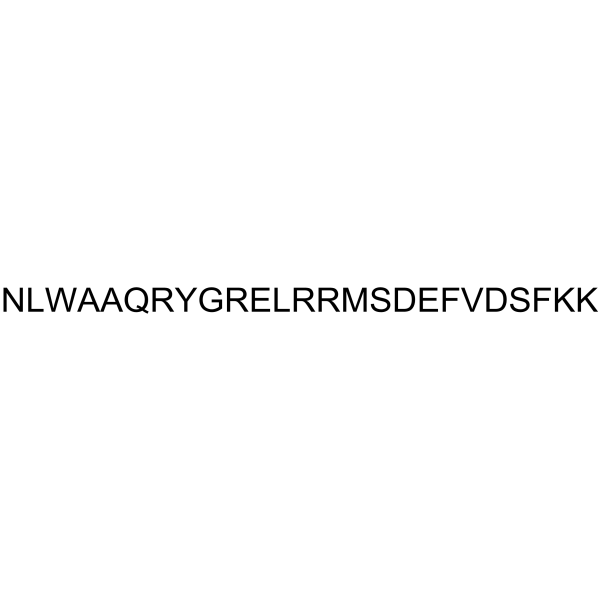上海金畔生物科技有限公司为生命科学和医药研发人员提供生物活性分子抑制剂、激动剂、特异性抑制剂、化合物库、重组蛋白,专注于信号通路和疾病研究领域。
BAD (103-127) (human)
BAD (103-127) (human),是 25-mer Bad 多肽,来自BAD 的BH3 结构域,可拮抗Bcl-xL 的作用。BAD (103-127) (human) 对 Bcl-xL 的亲和力是 16-mer 多肽的 800 倍。

BAD (103-127) (human) Chemical Structure
CAS No. : 331762-68-6
| 规格 | 是否有货 | ||
|---|---|---|---|
| 100 mg | 询价 | ||
| 250 mg | 询价 | ||
| 500 mg | 询价 |
* Please select Quantity before adding items.
| 生物活性 |
BAD (103-127) (human), the 25-mer Bad peptide, is derived from the BH3 domain of BAD, can antagonize the function of Bcl-xL. BAD (103-127) (human) is reported to have almost 800-fold higher affinity for Bcl-XL than the 16-mer peptide[1]. |
||||||||||||||||||||
|---|---|---|---|---|---|---|---|---|---|---|---|---|---|---|---|---|---|---|---|---|---|
| 分子量 |
3103.47 |
||||||||||||||||||||
| Formula |
C137H212N42O39S |
||||||||||||||||||||
| CAS 号 |
331762-68-6 |
||||||||||||||||||||
| Sequence Shortening |
NLWAAQRYGRELRRMSDEFVDSFKK |
||||||||||||||||||||
| 运输条件 |
Room temperature in continental US; may vary elsewhere. |
||||||||||||||||||||
| 储存方式 |
Please store the product under the recommended conditions in the Certificate of Analysis. |
||||||||||||||||||||
| Solvent & Solubility |
In Vitro:
H2O Peptide Solubility and Storage Guidelines: 1. Calculate the length of the peptide. 2. Calculate the overall charge of the entire peptide according to the following table:
3. Recommended solution:
|
||||||||||||||||||||
| 参考文献 |
|
所有产品仅用作科学研究或药证申报,我们不为任何个人用途提供产品和服务
